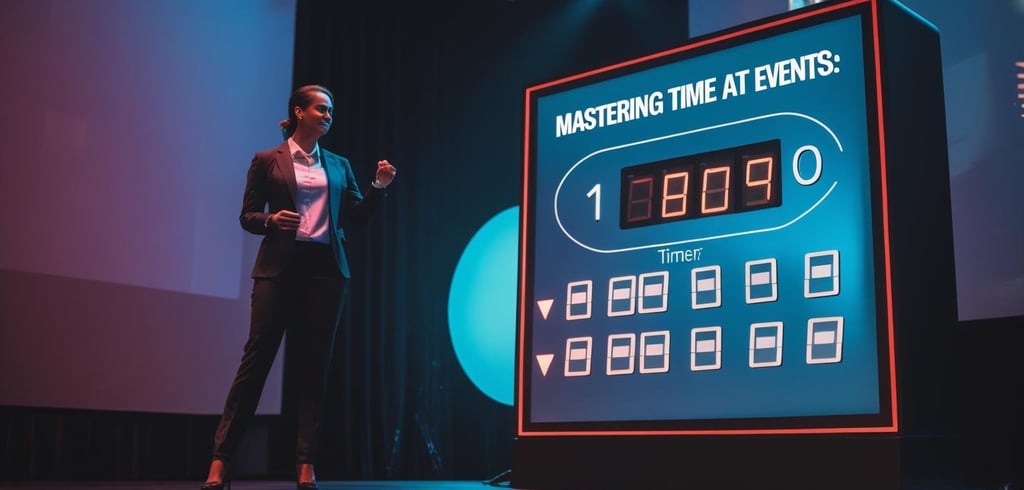Start sending invites for free - no card required - Click here
Harnessing Countdown Timers to Keep Webinars, Conferences, and Stage Sessions on Time
Time discipline is the invisible engine that powers every successful event—whether a lightning-fast webinar, a day-long conference, or a high-energy stage show. One of the simplest yet most effective ways to protect that engine is the humble countdown timer. From signaling when a webcast will go live to nudging a keynote speaker toward a crisp conclusion, timers create order, boost engagement, and preserve audience focus.
BLOGS
6/20/20253 min read


Time discipline is the invisible engine that powers every successful event—whether a lightning-fast webinar, a day-long conference, or a high-energy stage show. One of the simplest yet most effective ways to protect that engine is the humble countdown timer. From signaling when a webcast will go live to nudging a keynote speaker toward a crisp conclusion, timers create order, boost engagement, and preserve audience focus.
Below, we explore the many faces of event timing—countdown timer for webinar, conference timer, timer for presenters, and more—and share practical tips for weaving them into your production plan.
1 | Why a Countdown Timer for Webinar Sessions Matters
Online audiences are quick to click away if a start time slips. A clearly visible countdown timer for webinar does three things at once:
Builds anticipation—attendees see the seconds ticking and stay in the tab rather than wandering off.
Signals punctuality—hosts who start on time earn credibility.
Reduces tech anxiety—with a firm start in view, speakers and moderators can run final checks calmly.
Even a simple webinar timer—nothing flashy, just a steady numeric display—can trim drop-off rates and boost attendance by reassuring viewers that the session will begin exactly as promised.
2 | Managing Multi-Track Agendas with Countdown Timer for Sessions
Hybrid summits often juggle parallel workshops, fireside chats, and demos. A shared countdown timer for sessions keeps moderators, AV teams, and guests in sync. Post a timer on screens at the front of each room (or embed it in the stream overlay) so everyone knows precisely when to wrap up and transition.
Consistent timing helps avoid session drift, where one overlong panel cascades into a day of delays—something every planner dreads.
3 | Countdown Timer for Speakers vs. Timer for Speakers
At first glance, the terms look identical, but organizers often make a subtle distinction:
Countdown timer for speakers is the master clock visible to both audience and presenter.
Timer for speakers is a private cue—often a small screen on stage—showing only to the presenter.
Using both together offers transparency for attendees while giving presenters a discreet tool to pace themselves.
4 | Why Presenters Appreciate Private Timers
Even seasoned professionals lose track of minutes when adrenaline spikes. A modest countdown timer for presenters—tucked near the stage floor or on a secondary monitor—lets them glance down without breaking eye contact with the audience. Pair it with a timer for presenters that flashes yellow at the five-minute mark and red at the one-minute mark, and you’ll rarely see speakers run long again.
5 | Countdown Timer for Stage: Hidden Glue of Live Production
Behind every smooth-running show is a stage manager glued to a single display: the countdown timer for stage. Lighting cues, video rolls, and music stings all trigger off that clock. When presenters honor their slots, crew stress plummets and production quality soars.
Pro-tip: use synchronized network clocks so every device—stage monitors, backstage laptops, and streaming encoders—shares the same countdown. Even a five-second mismatch can create awkward pauses or rushed transitions.
6 | Conference Timer: Keeping Hundreds of People Aligned
Large-scale conferences cram dozens of micro-deadlines into one day. The conference timer sits at the center of this traffic circle—guiding attendees from coffee break to keynote, exhibitors from set-up to show-time, and staff from mic check to curtain call. Publishing the same timer on mobile apps and hallway screens removes guesswork and fosters a reputation for military-grade organization.
7 | Countdown Timer for Presentation: Rehearsal’s Secret Weapon
Solo presenters preparing for a big reveal often rehearse with a countdown timer for presentation. Watching the minutes tick down helps refine which stories land and which slides can go. The result? A tight narrative that ends on a crescendo instead of a frantic scramble through the last deck.
Encourage speakers to practice with the exact timer style they will see live; familiarity reduces stage nerves.
8 | Crafting a Friction-Free Timing Workflow
Standardize durations. Decide on default blocks—e.g., 20-minute talks, 5-minute Q&As—so timers are predictable.
Communicate clearly. Share timing rules in speaker briefings and agenda emails.
Test in real time. Include timers in every rehearsal; never assume they’ll behave on the day.
Assign a timing marshal. One person should own the master countdown timer and call audibles when schedules shift.
With these habits in place, your timing system becomes muscle memory for the entire crew.
9 | Respecting the Audience’s Clock
Attendees remember how an event made them feel. Nothing frustrates a busy professional more than sessions that drag. By investing in visible, reliable timers—from the opening countdown timer for webinar splash screen to the closing conference timer beep—you deliver a subtle promise: “We value your time.”
In a competitive landscape where people choose between dozens of digital engagements daily, that promise can win loyalty long after the final slide fades.
Final Word
Countdown timers are more than ticking numbers—they’re silent guardians of flow, energy, and professionalism. Adopt them thoughtfully—whether a private timer for speakers, a glowing countdown timer for stage, or a bold countdown timer for presentation—and watch your events transform from good to unforgettable.
BulkCalendar.in
Send Bulk & Mass Calendar Invites Instantly
Contact us
Engagement
sales@letscalendar.com
+44 (0) 203 916 5117
© 2025. All rights reserved.
Help?
